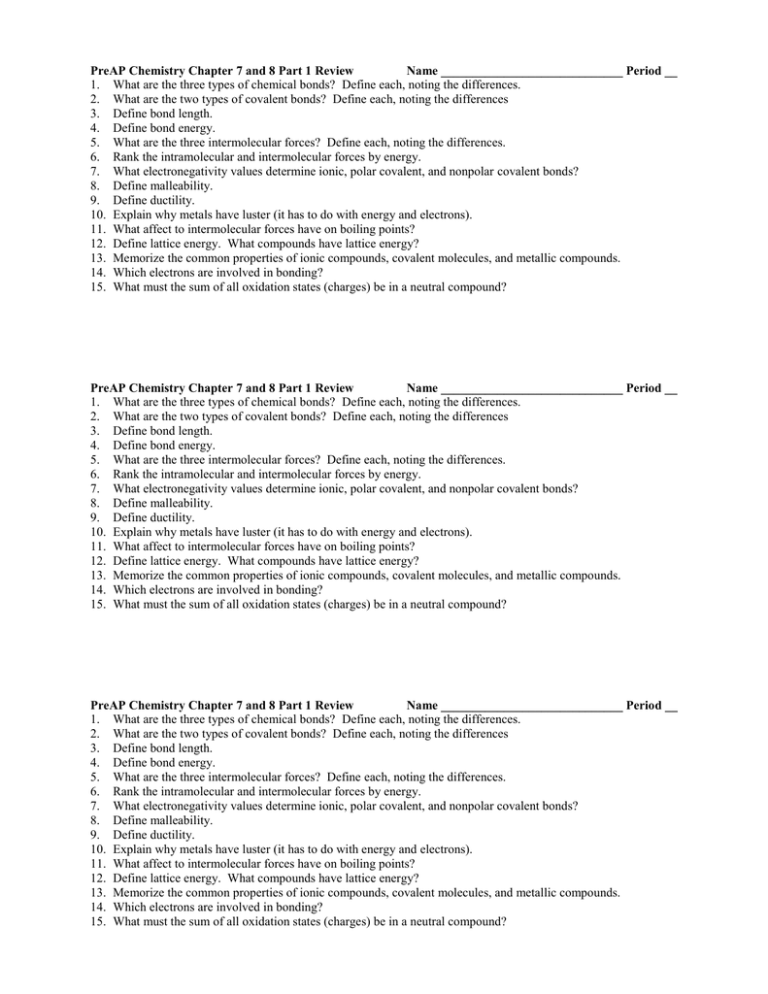PreAP Chemistry Chapter 7 and 8 Part 1 Review Name Period __
advertisement

PreAP Chemistry Chapter 7 and 8 Part 1 Review Name _____________________________ Period __ 1. What are the three types of chemical bonds? Define each, noting the differences. 2. What are the two types of covalent bonds? Define each, noting the differences 3. Define bond length. 4. Define bond energy. 5. What are the three intermolecular forces? Define each, noting the differences. 6. Rank the intramolecular and intermolecular forces by energy. 7. What electronegativity values determine ionic, polar covalent, and nonpolar covalent bonds? 8. Define malleability. 9. Define ductility. 10. Explain why metals have luster (it has to do with energy and electrons). 11. What affect to intermolecular forces have on boiling points? 12. Define lattice energy. What compounds have lattice energy? 13. Memorize the common properties of ionic compounds, covalent molecules, and metallic compounds. 14. Which electrons are involved in bonding? 15. What must the sum of all oxidation states (charges) be in a neutral compound? PreAP Chemistry Chapter 7 and 8 Part 1 Review Name _____________________________ Period __ 1. What are the three types of chemical bonds? Define each, noting the differences. 2. What are the two types of covalent bonds? Define each, noting the differences 3. Define bond length. 4. Define bond energy. 5. What are the three intermolecular forces? Define each, noting the differences. 6. Rank the intramolecular and intermolecular forces by energy. 7. What electronegativity values determine ionic, polar covalent, and nonpolar covalent bonds? 8. Define malleability. 9. Define ductility. 10. Explain why metals have luster (it has to do with energy and electrons). 11. What affect to intermolecular forces have on boiling points? 12. Define lattice energy. What compounds have lattice energy? 13. Memorize the common properties of ionic compounds, covalent molecules, and metallic compounds. 14. Which electrons are involved in bonding? 15. What must the sum of all oxidation states (charges) be in a neutral compound? PreAP Chemistry Chapter 7 and 8 Part 1 Review Name _____________________________ Period __ 1. What are the three types of chemical bonds? Define each, noting the differences. 2. What are the two types of covalent bonds? Define each, noting the differences 3. Define bond length. 4. Define bond energy. 5. What are the three intermolecular forces? Define each, noting the differences. 6. Rank the intramolecular and intermolecular forces by energy. 7. What electronegativity values determine ionic, polar covalent, and nonpolar covalent bonds? 8. Define malleability. 9. Define ductility. 10. Explain why metals have luster (it has to do with energy and electrons). 11. What affect to intermolecular forces have on boiling points? 12. Define lattice energy. What compounds have lattice energy? 13. Memorize the common properties of ionic compounds, covalent molecules, and metallic compounds. 14. Which electrons are involved in bonding? 15. What must the sum of all oxidation states (charges) be in a neutral compound?





